wetlands
Showing 13–24 of 26 results
-
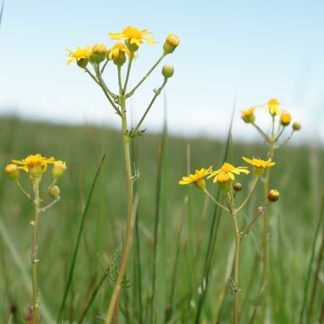
Packera pseudaurea / falsegold groundsel
- yellow, flat-topped cluster of daisy-like flowers
- oval, erect basal leaves with long petioles and round/blunt-toothed edges
- generally in moist to wet habitats
-

Pedicularis groenlandica / elephant head
- flowers range from pink to purple or white
- flowers each have a long, pointed, upward curving beak like an elephant's trunk and lateral lobes that look like elephant's ears
- sharply-toothed fernlike leaves
- wet environments in late June, early July
-

Phalaris arundinacea / reed canarygrass
- large, coarse, erect grass
- long, flat blades with pointy tips... from base
- distinct ligule—membranous and long
- large but compact inflorescences (panicles)
- often in dense monocultures, e.g. on river banks
-

Platanthera dilatata / white bog orchid
- dense cluster of bright white, clove or cinnamon scented flowers
- 2 wing-like sepals, a hood, and a lower lip with a spur
- 3-6 principle leaves... alternate, lance-shaped
- in boggy wet areas
-
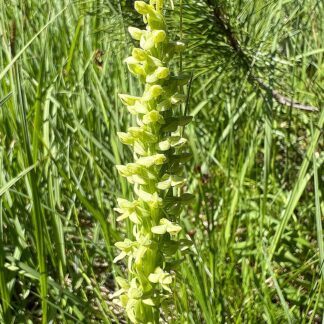
Platanthera huronensis / green bog orchid
- usually in bogs, fens, wetlands
- up to two feet tall, but often shorter
- thick, nearly vertical leaves with parallel veins (i.e. grass-like)
- up to 75 very small flowers per stem (raceme)
- flowers -light green to greenish-white; two petals, three sepals, a lip and club-like spur
- lip is not pouch-like
-

Polemonium occidentale / western Jacob’s ladder
- brilliantly blue flowers with bright yellow anthers, in clusters
- pinnately compound leaves with up to 27 narrow, lance-shaped leaflets
- most leaves on separate stems from the flowers
- usually in wetlands
-

Scutellaria galericulata / marsh skullcap
- riparian zones and wetlands
- blue, trumpet shaped (legume) flowers; usually in pairs on same side of a stem
- flowers not at the top of the stems
- square stems, widely spaced opposite leaves; adjacent pairs at right angles
-
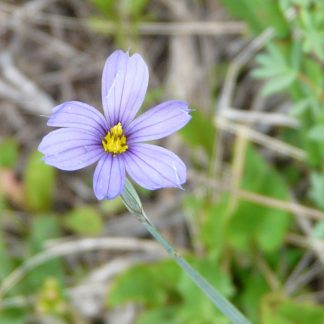
Sisyrinchium idahoense / Idaho blue-eyed grass
- six blue, notched "petals" with yellow center
- single flower; naked stem
- narrow, grass-like, basal leaves
- fens and wet meadows
-

Streptopus amplexifolius / white twisted-stalk
- creeping herb
- oval, clasping leaves; parallel veins; sharp tip
- pronounced stem "kink" at each node gives twisted look
- drooping, cream-colored flowers, 6 recurved tepals, borne singly
- single, elongated red berries in fall
- found in moist undergrowth
-
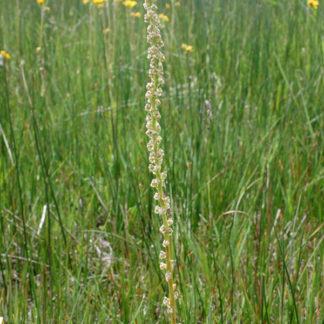
Triglochin maritima / seaside arrowgrass
- in bogs, fens, and roadsides through them
- "grass-like" leaves - semicircular cross section with a groove down the middle
- tall flowering spikes with many crowded, green/yellow-ish, teeny flowers
- clonal, so often in widely spaced clumps
-
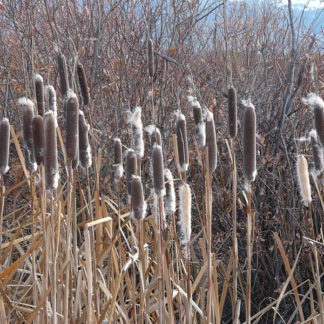
Typha latifolia / cattail
- tall, grass-like with thick, long, flat leaves
- in wet areas, especially streams and stream banks
- inflorescence club-like spike; yellow (male) above, green (female) below
- seed head dark brown club, with bare spike above
- fruits (seeds) white & fluffy, released in late summer, autumn, winter
-
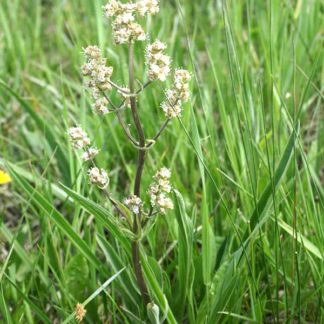
Valeriana edulis / hairy valerian
- long-lived, herbaceous, dioecious perennial - limited to marshes and fens
- grass-like basal leaves; pin-like lobed, stem leaves
- teeny male flowers, white with five fused petals
- sub-millimeter female flowers
- male and female flowers usually on different plants
- overall plant stands out above wetland grasses, rushes etc.
Showing 13–24 of 26 results